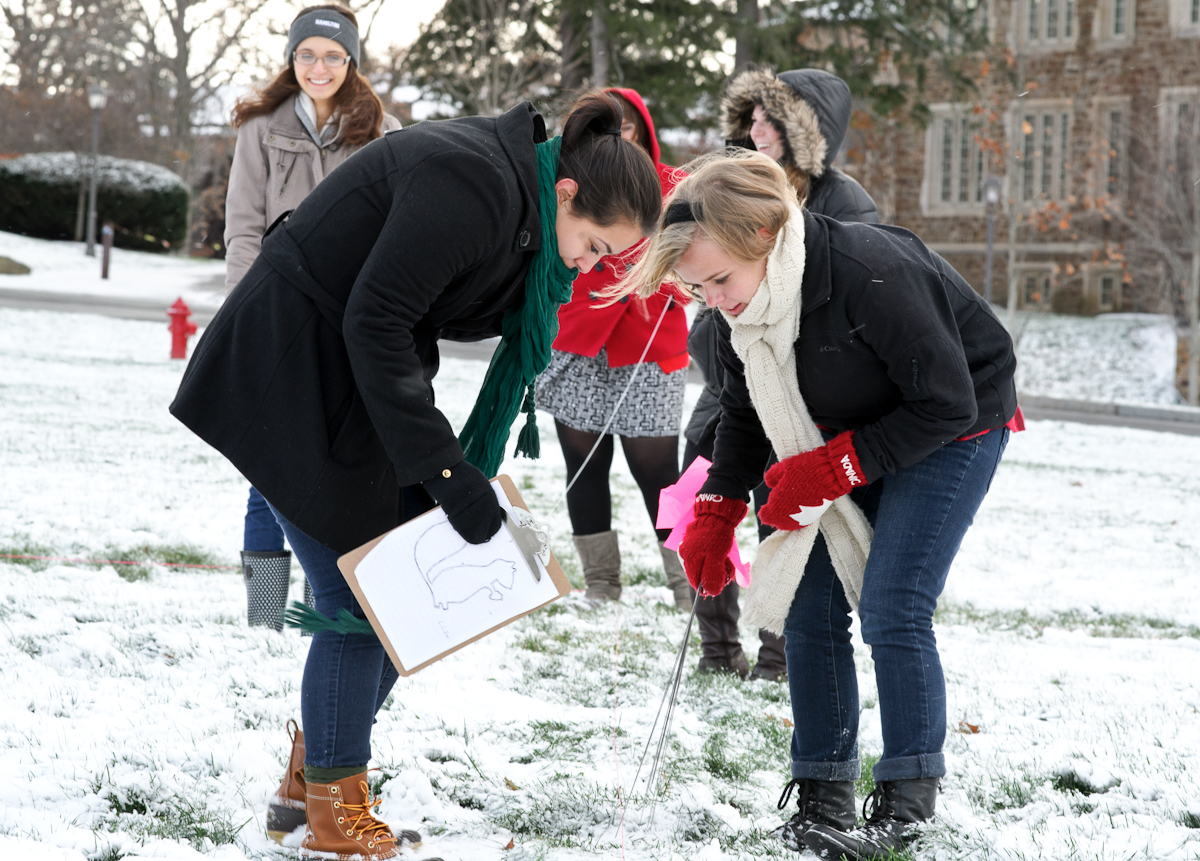
If you were wondering about that series of pink flags that were later supplanted by white chalk designs on the area between Admissions and the Taylor Science Center, Visiting Assistant Professor of Anthropology Khori Newlander ’04 can explain. It was all part of a project for his course “Frauds and Fantastic Claims in Archaeology.”
The class “was discussing the fantastical claim that aliens came to earth in the past and taught humans how to make pyramids and monuments, among other things,” Newlander explained. “Proponents of this view cite the Nazca lines (humongous pictures drawn on the ground) in Peru as evidence of this claim. They claim that the lines could not have been drawn without the help of aliens hovering overhead.”
In order to demonstrate that humans could have made these pictures, Newlander had his class make their own designs; they ended up with designs of a squirrel and a moustache. He established the central axis for the designs and then marked them out with pin flags at five-foot intervals, also providing sketches of the designs on graph paper.
After using paint to connect the dots (that is, the flags), the class removed the pink string and pin flags, leaving their own designs. Newlander said he chose the fields between the Science Center and Admissions so that the class could look down on the designs from the Science Center once they were done.
In describing the class, Newlander said he and the students examine fantastic and extraordinary interpretations of archaeological remains that are popular subjects for television shows, magazine articles, books and websites.
The claims they’ve tackled so far include the notion that explorers from China or West Africa “discovered” the Americas before Columbus; a “lost race” from Europe built the great earthen mounds of the American Midwest and Midsouth; and we owe the origins of civilization to people from Atlantis, who taught us how to farm, write, and build monumental architecture. “Professional archaeologists, for their part, often treat these claims as fringe ideas or ‘pseudo-science’ because they lack verifiable physical evidence,” Newlander explained.
“While these ideas may seem entertaining and harmless, many of these claims, in fact, promote ethnocentric and racist views of the past,” he contended. “Many of the pseudo-archaeological claims featured in popular media argue that indigenous people, especially in North and South America, owe their cultural achievements to contact with more ‘advanced’ or ‘civilized’ groups.”
Newlander said that the assumption underlying these claims is that indigenous peoples could not have produced their many archaeological wonders (e.g., ancient writing systems, knowledge of astronomy, complex mathematics, and monumental architecture) without help from outsiders. In nearly all examples, he said, “these ‘outsiders’ are people of a different ‘race’ than indigenous groups. As such, fantastic interpretations of the past have been and continue to be used as powerful political tools to deny indigenous peoples their land and cultural heritage.”
Newlander cited the experiment as a success. “By successfully creating our own ‘Hamilton Lines’ using very simple tools and measurements, we demonstrated the value of replicative studies for testing the fantastical explanations so often offered to account for archaeological phenomena,” Newlander concluded.
Posted December 9, 2013
